Michael J. Behe's Blog, page 488
May 1, 2019
BBC on the “evolution” of robots (missing the “by design” part)
BBC has done a mini-series on the “evolution” of robots, even speaking of invasive species. The silence on the “by design” part is conspicuous, especially as they use a biologist (male) and an engineer (female) as their key personalities:
The blindness to the obvious is glaring, inadvertently showing the blinding power of a dominant, flawed paradigm.
But, what about reproduction and evolution? Here, von Neumann’s self replicating machine gives us a window into the further required level of design involved:
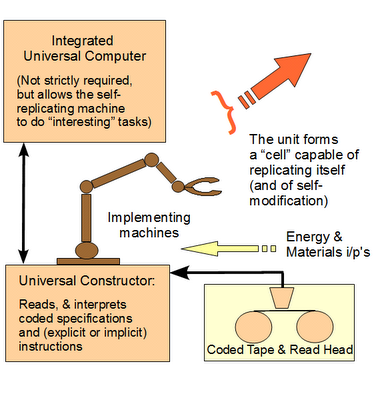 A von Neumann kinematic self-replicator
A von Neumann kinematic self-replicatorWhat we are seeing, in short, is induced blindness to the obvious.
Where, of course, simply the use of alphanumeric, algorithmic code
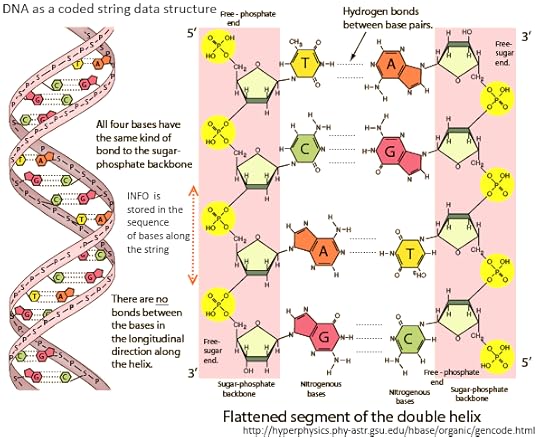 DNA is a string digital data structure which stores coded information in the specific sequence of bases, G/C/A/T, both for protein coding and for regulation/control
DNA is a string digital data structure which stores coded information in the specific sequence of bases, G/C/A/T, both for protein coding and for regulation/control. . . and thus, communication systems
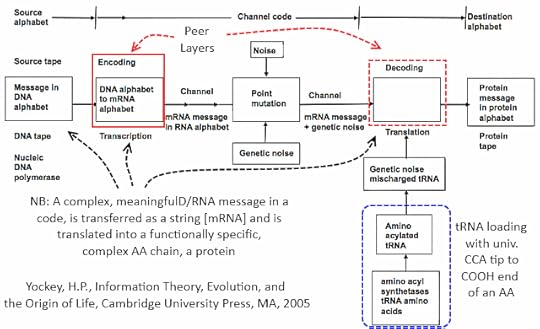 Yockey’s analysis of protein synthesis as a code-based communication process
Yockey’s analysis of protein synthesis as a code-based communication process. . . in D/RNA to make proteins is a big clue that language, intelligence and design are antecedent to cell-based, protein-using biological life:
 Protein Synthesis (HT: Wiki Media)
Protein Synthesis (HT: Wiki Media)We need to ask some very pointed questions about what is going on, not only in the media but in academic and professional institutions. Such blindness is not accidental. END
Copyright © 2019 Uncommon Descent . This Feed is for personal non-commercial use only. If you are not reading this material in your news aggregator, the site you are looking at is guilty of copyright infringement UNLESS EXPLICIT PERMISSION OTHERWISE HAS BEEN GIVEN. Please contact legal@uncommondescent.com so we can take legal action immediately.
Plugin by Taragana
April 30, 2019
Could the replication crisis be good for science?
 What’s hot? What’s not?/Niklas Bildhauer, Wikimedia
What’s hot? What’s not?/Niklas Bildhauer, WikimediaAn educational psychologist sees a silver lining:
The Reproducibility Project, a collaboration of 270 psychologists, has attempted to replicate 100 psychology studies, while a 2018 report examined studies published in the prestigious scholarly journals Nature and Science between 2010 and 2015. These efforts find that about two-thirds of studies do replicate to some degree, but that the strength of the findings is often weaker than originally claimed.Eric Loken, “The replication crisis is good for science” at The Conversation
Okay, so that’s not the silver lining. This is:
Awareness about the replication crisis appears to be promoting better behavior among scientists. Twenty years ago, the cycle for publication was basically complete after a scientist convinced three reviewers and an editor that the work was sound. Yes, the published research would become part of the literature, and therefore open to review – but that was a slow-moving process.
Today, the stakes have been raised for researchers. They know that there’s the possibility that their study might be reviewed by thousands of opinionated commenters on the internet or by a high-profile group like the Reproducibility Project. Some journals now require scientists to make their data and computer code available, which makes it likelier that others will catch errors in their work. What’s more, some scientists can now “preregister” their hypotheses before starting their study – the equivalent of calling your shot before you take it.Eric Loken, “The replication crisis is good for science” at The Conversation
However, that lining is rather thin. Only one in four scientists uses these “open science” techniques.
Maybe the best thing to come out of it is that many people will realize that one can’t just trust science blindly, as if there were a built-in reason why findings that don’t sound right couldn’t be wrong.
Follow UD News at Twitter!
See also: Does liberal bias deepen the replication crisis in psychology? Consider the sheer number of ridiculous Sokal hoaxes that have played psychology journals. That would only be possible in an environment that is so overwhelmingly of one persuasion that few academics step back and say things like “What? ‘Misgendering’ dogs? This is ridiculous! They daren’t because someone’s feelings might be hurt.
Copyright © 2019 Uncommon Descent . This Feed is for personal non-commercial use only. If you are not reading this material in your news aggregator, the site you are looking at is guilty of copyright infringement UNLESS EXPLICIT PERMISSION OTHERWISE HAS BEEN GIVEN. Please contact legal@uncommondescent.com so we can take legal action immediately.
Plugin by Taragana
What’s the difference between a wolf and a dog? Terminology, it seems…
 “Try and look as much like a lost dog as possible… That’s the Humane Society over there… “
“Try and look as much like a lost dog as possible… That’s the Humane Society over there… “An anthropologist suggests a new way of looking at the topic:
When distinguishing between a wolf and a dog, we face the classic challenge of being able to sort out differences on a meaningful level. Indeed, one cannot do this without engaging the issue of meaning. Do we have here essentially ‘the same animal’ or two quite clearly different species and beings, as different as humans and Neanderthals, for example (or even more so)? One of the challenges in these questions is that they do not have straightforward scientific or biological answers – we need other toolkits in our conceptual frameworks. One such conceptual framework comes from biosemiotics, an interdisciplinary approach that recognises the fundamental importance of molecules and other biological markers in shaping our existence but also readily acknowledges that there is no hard and fast line between biology and philosophy, or biology and culture.
As a whole, biosemioticians aim to make sense of the signs present in ecology, and track the ways in which such signs both mediate and are mediated by relationships that exist across different organisms. … Katja Pettinen, “Will We Ever Know the Difference Between a Wolf and a Dog?” at RealClearScience
An interesting approach.
Perhaps most groups of canines have never been very separate for any length of time and that fact may have served them well.
Modern dog breeds were created in Victorian Britain. The evolution of the domestic dog goes back tens of thousands of years – however, the multiple forms we see today are just 150 years old. Before the Victorian era, there were different types of dog, but there were not that many, and they were largely defined by their function. They were like the colours of a rainbow: variations within each type, shading into each other at the margins. And many terms were used for the different dogs: breed, kind, race, sort, strain, type and variety. Michael Worboys, “How Humans Created the Modern Concept of Dog Breeds” at RealClearScience
The whole basis of the diversity, of course, is that humans controlled dogs’ breeding while feeding and protecting them. Otherwise, they’d all be wolfhounds in a few generations. Worboys offers some information about the recreation of the giant Irish wolfhound.
See also: A physicist looks at biology’s problem of “speciation” in humans
Follow UD News at Twitter!
Copyright © 2019 Uncommon Descent . This Feed is for personal non-commercial use only. If you are not reading this material in your news aggregator, the site you are looking at is guilty of copyright infringement UNLESS EXPLICIT PERMISSION OTHERWISE HAS BEEN GIVEN. Please contact legal@uncommondescent.com so we can take legal action immediately.
Plugin by Taragana
Researchers: Most life-friendly planets orbiting young stars would quickly lose atmosphere
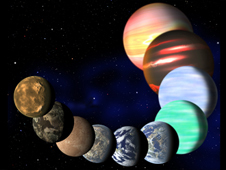 lucky exoplanets, they even exist/NAA
lucky exoplanets, they even exist/NAARecently, we heard that the discovery of life elsewhere in the universe was seeming more “inevitable” all the time, maybe soon. From ScienceDaily:
Researchers based at the University of Vienna and the Space Research Institute of the ÖAW in Graz have calculated for the first time how rapidly an Earth-like atmosphere would be lost from a planet orbiting a very active young star. Their calculations have shown that extreme hydrodynamic losses of the atmosphere would take place, leading to an Earth-like atmosphere being entirely lost in less that one million years, which for the evolution of a planet is almost instantaneous.
These results have significant implications for the early evolution of the Earth and for the possibility of Earth-like atmospheres forming around M-dwarfs. For the Earth, the most likely explanation for why the atmosphere was not lost is that the early atmosphere was dominated by carbon dioxide, which cools the upper atmosphere by emitting infrared radiation to space, thereby protecting it from the heating by the early Sun’s high activity. The Earth’s atmosphere could not have become Nitrogen dominated, as it is today, until after several hundred million years when the Sun’s activity decrease to much lower levels.
More dramatically, the results of this study imply that for planets orbiting M-dwarf, the planets can only form Earth-like atmospheres and surfaces after the activity levels of the stars decrease, which can take up to several billion years. More likely is that many of the planets orbiting M-dwarf stars to have very thin or possible no atmospheres. In both cases, life forming in such systems appears less likely than previously believed. Paper. (open access) – C. P. Johnstone, M. L. Khodachenko, T. Lüftinger, K. G. Kislyakova, H. Lammer, M. Güdel. Extreme hydrodynamic losses of Earth-like atmospheres in the habitable zones of very active stars. Astronomy & Astrophysics, 2019; 624: L10 DOI: 10.1051/0004-6361/201935279 More.
Is finding life elsewhere “inevitable” because that’s how it happens in science fiction?
How to put this gently?: In science fiction, “They’re out there” because that is the premise of the story. It may or may not work as directed in real life.
See also: Researcher: Why finding extraterrestrial life “now seems inevitable,” maybe soon. He ends with, “The ancient question ‘Are we alone?’ has graduated from being a philosophical musing to a testable hypothesis. We should be prepared for an answer.” It’s worth asking another question: What if, after decades of research, no answer comes? What would that change?
Faint hopes easily revived: Life may be evolving on closest exoplanet
Forbes cosmology commentator: Maybe we ARE alone
Still no space aliens? That’s because they are keeping us in a zoo!
and
Tales of an invented god
Follow UD News at Twitter!
Copyright © 2019 Uncommon Descent . This Feed is for personal non-commercial use only. If you are not reading this material in your news aggregator, the site you are looking at is guilty of copyright infringement UNLESS EXPLICIT PERMISSION OTHERWISE HAS BEEN GIVEN. Please contact legal@uncommondescent.com so we can take legal action immediately.
Plugin by Taragana
AI meets Eek! Eek!

This summer, AI will be put through virtual mazes designed to test the intelligence of lab animals:
Artificial intelligence systems perform well when problems that are sharply defined in advance. That’s why they can win at chess and Go. However, most problems an animal faces are not sharply defined. A wolf pack must feed itself in a vast wilderness; there is a great deal of information but most of it is imprecise. There are immutable laws of nature that the wolves obey without understanding. But no rules of play govern their quest for survival. Thus, intelligence means something different to a wolf than to a programmer.
Researchers now want to study this.
The project must tackle the thorny problem of how we understand animal intelligence. Measurements are contested. For example, if human intelligence is used as a benchmark, it may be irrelevant. As J. Scott Turner, known for research on termite mounds, has pointed out, a mound’s inhabitants can be seen as a “giant crawling brain,” which makes the type of intelligence difficult to compare with human intelligence, which is intrinsically individual…
There may also be factors in the intelligence of life forms that we have not captured in AI. For example, even bacteria face choices and make decisions. Even an amoeba or a fruit fly is smarter, about some things, than your computer. These abilities in life forms that lack a brain may involve factors we do not yet fully understand, if only because AI is modeled in part on human thought processes. “Virtual Olympics: Animal IQ vs AI” at Mind Matters
Safe prediction: We will hear remarkable stories from media.
See also: Even Bacteria Are Purpose-Driven The recent finding that bacteria can make individual decisions may help design better antibiotics
Follow UD News at Twitter!
Copyright © 2019 Uncommon Descent . This Feed is for personal non-commercial use only. If you are not reading this material in your news aggregator, the site you are looking at is guilty of copyright infringement UNLESS EXPLICIT PERMISSION OTHERWISE HAS BEEN GIVEN. Please contact legal@uncommondescent.com so we can take legal action immediately.
Plugin by Taragana
April 29, 2019
“Amazed” researchers: Mitochondria found that produce energy without any DNA
The life form is a dinoflagellate, a marine plankton parasite. From ScienceDaily:
The mitochondria of the dinoflagellate Amoebophrya ceratii appear to produce energy just like our own mitochondria, but without any genetic material, as the team reports in the journal Science Advances. …
In this context, the team sequenced the genome (all the genetic material) of Amoebophrya, which consists of roughly 100 million base pairs. That’s extremely low by dinoflagellate standards: other species have genome a thousand times larger, which is much larger than even the human genome. That being said, a small genome isn’t exactly unusual for a parasite. Many of those pursuing this lifestyle don’t produce all of the metabolic products they need to survive; they simply steal them from their host. Though this makes them host-dependent, it also means there are many genes they can simply do without. But that’s not the road that Amoebophrya ceratii chose to go down. “In this species, nearly all metabolic processes still work, so it should also be able to get by quite well on its own,” says Uwe John. And it can do so with significantly less genetic material than any other dinoflagellate.
This reduction is especially pronounced in that part of the genome that lies outside the nucleus. In plants and algae, their own DNA is not just found in the nucleus and mitochondria, but also in the plastids, which they need for photosynthesis. For dinoflagellates in general, this plastid DNA is fairly basic, and consists of only 14 genes. Yet Amoebophrya ceratii would appear to have done away with the plastids entirely, and with all but one of their genes.
Yet the ‘budget cuts’ that the parasite has pursued with regard to its mitochondria are even more impressive. In related species, these tiny power plants’ DNA still contains three genes, which experts have generally assumed to be indispensable. But Amoebophrya ceratii has apparently cut out the mitochondria genome entirely; despite painstaking efforts, the team was unable to find any trace of it. Two of the three genes are nowhere to be found, and the third, cytochrome c oxidase 1 (COX1 or COI), has migrated to the nucleus. “That absolutely amazed me,” says Uwe John, “because there’s no other oxygen-breathing life-form on record that has no genetic material of its own in its mitochondria.”
This downsizing could come in handy when the parasites need to rapidly form a large number of new dinospores… Paper. (open access) – Uwe John, Yameng Lu, Sylke Wohlrab, Marco Groth, Jan Janouškovec, Gurjeet S. Kohli, Felix C. Mark, Ulf Bickmeyer, Sarah Farhat, Marius Felder, Stephan Frickenhaus, Laure Guillou, Patrick J. Keeling, Ahmed Moustafa, Betina M. Porcel, Klaus Valentin, Gernot Glöckner. An aerobic eukaryotic parasite with functional mitochondria that likely lacks a mitochondrial genome. Science Advances, 2019; 5 (4): eaav1110 DOI: 10.1126/sciadv.aav1110 More.
Does anyone remember when genes were still a “thing”?
The researchers go on to speculate as to how, despite appearances, not having any mitochondrial DNA is an evolutionary advantage. But wait a minute. Maybe it isn’t. A large proportion of the types of life forms that have ever existed are extinct. Insisting on explanations that show how a given change is an example of fitness created by natural selection requires us to ignore the possibility that the life form may, in fact, be on the way out. As Colin Patterson used to say, we don’t know why most extinctions occur. As long as we keep mapping genomes, we are sure to find more odd stuff.
Maybe the next time something happens that requires the use of mitochondrial DNA, that particular species will disappear. No, we don’t know that but neither do the researchers know that whatever we find is an example of fitness. One wishes they felt free to say, maybe not. Time will tell.
See also: Researcher: “No Rhyme Or Reason” To Unexpected Sea Anemone Genome
Two Jellyfish Genomes Differ “As Drastically As Humans Do From Sea Urchins. ”
Follow UD News at Twitter!
Copyright © 2019 Uncommon Descent . This Feed is for personal non-commercial use only. If you are not reading this material in your news aggregator, the site you are looking at is guilty of copyright infringement UNLESS EXPLICIT PERMISSION OTHERWISE HAS BEEN GIVEN. Please contact legal@uncommondescent.com so we can take legal action immediately.
Plugin by Taragana
ID-friendly scientist’s book features three Nobel Prize winners’ endorsements
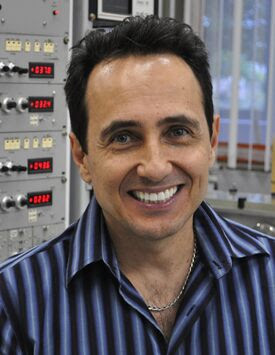
Marcos Eberlin’s Foresight: How the Chemistry of Life Reveals Planning and Purpose is now available at Amazon:
The case for intelligent design begins with biology and paleontology, pushes onward to cosmology, physics — and now chemistry. Marcos Eberlin is the superstar Brazilian chemist and member of the Brazilian Academy of Sciences who founded and for a quarter century headed the Thomson Mass Spectrometry Laboratory. His new book, Foresight: How the Chemistry of Life Reveals Planning and Purpose, is out now from Discovery Institute Press.
Foresight carries endorsements not just from one Nobel Prize-winning scientist. No, not just two either. But three. They are Sir John B. Gurdon (Physiology or Medicine, 2012), Gerhard Ertl (Chemistry, 2007), and Brian D. Josephson (Physics, 1973). Of course, accolades from famous people don’t guarantee that the conclusion of the book is right. But at some point the critics need to admit that the accumulating strength of the argument demands, at last, an adequate response…
In case after case, he argues that life purposefully devised “solutions that anticipated problems before they arose,” a sure “hallmark of mind.” The unintelligent Darwinian process lacks the capacity for such engineering but so do other “alternative evolutionary proposals” (neutral evolution, evolutionary developmental biology, natural genetic engineering, a hypothetical multiverse, and other popular proposals). David Klinghoffer, “With Three Nobel Endorsements, Chemist Marcos Eberlin Advances Case for Intelligent Design” at Evolution News and Science Today:
Marcos Eberlin’s Foresight: How the Chemistry of Life Reveals Planning and Purpose is now available at Amazon:
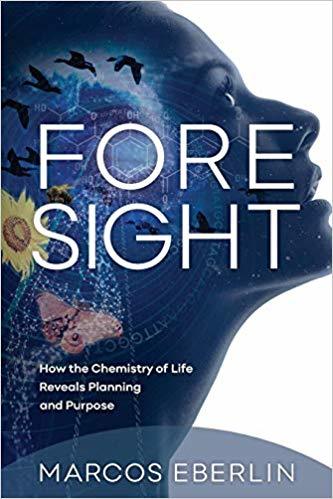
Here are the endorsements:
“I am happy to recommend this to those interested in the chemistry of life. The author is well established in the field of chemistry and presents the current interest in biology in the context of chemistry.”—Sir John B. Gurdon, PhD, Nobel Prize in Physiology or Medicine (2012)
“An interesting study of the part played by foresight in biology.”—Brian David Josephson, Nobel Prize in Physics (1973)
“Despite the immense increase of knowledge during the past few centuries, there still exist important aspects of nature for which our scientific understanding reaches its limits. Eberlin describes in a concise manner a large number of such phenomena, ranging from life to astrophysics. Whenever in the past such a limit was reached, faith came into play. Eberlin calls this principle ‘foresight.’ Regardless of whether one shares Eberlin’s approach, it is definitely becoming clear that nature is still full of secrets which are beyond our rational understanding and force us to humility.”—Gerhard Ertl, PhD, Nobel Prize in Chemistry (2007)
Of course, many will respond by saying that Nobels are given out too easily these days…
More later. Meanwhile,
ID Conference Intended For Portugal Had To Flee To Spain “A group of students at the University of the Algarve, in Faro, Portugal, wanted to have a one-day conference on ID at the university. They invited Professor Marcos Eberlin of Campinas State University in Brazil (the 2016 Thomson Medal winner) and me, to speak. The conference was scheduled for Monday, October 23, with university endorsement. (2017)”
Brazilian chemist explains who ID informs his science
and
ID-friendly Brazilian prof wins medal
Note: The main thing for students is to get that degree without ever becoming like the Darwinians who award it.
Copyright © 2019 Uncommon Descent . This Feed is for personal non-commercial use only. If you are not reading this material in your news aggregator, the site you are looking at is guilty of copyright infringement UNLESS EXPLICIT PERMISSION OTHERWISE HAS BEEN GIVEN. Please contact legal@uncommondescent.com so we can take legal action immediately.
Plugin by Taragana
Falsifiability is overrated, some cosmologists say
 Big Bang/NASA
Big Bang/NASAWe seem to be talking a lot about falsifiability these days. Many cosmologists don’t like Karl Popper’s concept of falsifiability because it gets in the way of simply assuming that concepts like string theory and the multiverse are correct because, well, because they just must be. Many would like to loosen the concept of falsifiability to allow for such cool but unfalsifiable concepts in science:
Take, for example, supersymmetry. SUSY is an extension of the Standard Model in which each known particle is paired with a supersymmetric partner. The theory is a natural outgrowth of a mathematical symmetry of spacetime, in ways similar to the Standard Model itself. It’s well established within particle physics, even though supersymmetric particles, if they exist, may be out of scientists’ experimental reach.
SUSY could potentially resolve some major mysteries in modern physics. For one, all of those supersymmetric particles could be the reason the mass of the Higgs boson is smaller than quantum mechanics says it should be.
“Quantum mechanics says that [the Higgs boson] mass should blow up to the largest mass scale possible,” says Howard Baer of the University of Oklahoma. That’s because masses in quantum theory are the result of contributions from many different particles involved in interactions—and the Higgs field, which gives other particles mass, racks up a lot of these interactions. But the Higgs mass isn’t huge, which requires an explanation.
“Something else would have to be tuned to a huge negative [value] in order to cancel [the huge positive value of those interactions] and give you the observed value,” Baer says. That level of coincidence, known as a “fine-tuning problem,” makes physicists itchy. “It’s like trying to play the lottery. It’s possible you might win, but really you’re almost certain to lose.” Matthew R. Francis, “Falsifiability and physics” at Symmetry
The article doesn’t explain what the “fine-tuning problem” means. It means that the universe shows evidence of design. No one has been able to explain that away.
However, if basic thinking in science is jerked around enough, maybe ideas that don’t work can be offered social promotions and sit right alongside demonstrated ones.
Sure. That’ll work.
See also: Laszlo Bencze: The key to falsifiability of not evidence but observability The multiverse theory is irrefutable because alternate universes are, by definition, forever inaccessible. (If they were accessible through some very difficult convoluted route, they would still be part of our universe.)
Sabine Hossenfelder on the flight from falsifiability Hossenfelder is right to be concerned. Some cosmologists would like to dump falsifiability as a criterion. If they could, they would remove an obstacle to demanding public belief in ideas like the multiverse.
and
What becomes of science when the evidence does not matter?
Follow UD News at Twitter!
Copyright © 2019 Uncommon Descent . This Feed is for personal non-commercial use only. If you are not reading this material in your news aggregator, the site you are looking at is guilty of copyright infringement UNLESS EXPLICIT PERMISSION OTHERWISE HAS BEEN GIVEN. Please contact legal@uncommondescent.com so we can take legal action immediately.
Plugin by Taragana
The Multiverse is Anti-Scientific
The UD News Desk’s latest post has me thinking.
The multiverse is not only unscientific, it is positively anti-scientific. If there are an incomprehensibly vast (I believe some say even infinite, though that is hard to conceptualize) number of universes, then any being or phenomenon can be explained by “we just happen to live in the universe in which, by sheer dumb luck, that being or phenomenon was instantiated.” This boils down to: “Anything and everything can be explained as the result of sheer dumb luck.”
I take it that science is the search for causes upon which predictions can be based. For example, in the movie Apollo 13, NASA scientists calculated the exact number of seconds the astronauts needed to burn their engine in order to propel the module to intercept the earth. This calculation was based on a prediction derived from the laws of gravity.
Contrast that scientific approach with an explanation of a particular pattern of sand and detritus on the seashore. We can say of that pattern that it was the result of the random forces of wind and waves that caused the sand and detritus to come to rest on the seashore. That explanation would be true but trivial. It would be true because it would be a correct account of what happened. It would be trivial, because it would be utterly useless to predict any future pattern of sand and detritus on the seashore.
The explanation “we just happen to be in the universe where by sheer dumb luck this being or phenomenon was instantiated” is, from a scientific perspective, identical to “this pattern of sand and detritus resulted from random forces of wind and waives.” Even if it is true, it is scientifically trivial.
The multiverse is also anti-scientific on another related but independent ground. It seems obvious that the “we just happen to be in the universe where by sheer dumb luck this being or phenomenon was instantiated” explanation may be invoked to explain absolutely anything. And it if that is true, it is also obvious that an explanation that “explains” everything, in fact explains nothing. Why? Because the same “explanation” for a being or phenomenon could be used to explain both the existence of the being or phenomenon and the non-existence of the being or phenomenon at that same time. Thus, with respect to any phenomenon X, resort to “we just happen to live in the universe where phenomenon X occurs” explains the existence of the observed phenomenon. But if phenomenon X were not observed, “we just happen to live in the universe where phenomenon X fails to occur” has equal explanatory value.
This is all glaringly obvious and easy to grasp with a few moments’ reflection. It makes me wonder why a lot of otherwise brilliant people are so eager to jump on the multiverse bandwagon. Actually, that’s not true. I know why. Their faith in metaphysical materialism requires them to check their brains at the door and espouse the patently absurd.
Copyright © 2019 Uncommon Descent . This Feed is for personal non-commercial use only. If you are not reading this material in your news aggregator, the site you are looking at is guilty of copyright infringement UNLESS EXPLICIT PERMISSION OTHERWISE HAS BEEN GIVEN. Please contact legal@uncommondescent.com so we can take legal action immediately.
Plugin by Taragana
The key to falsifiability of not evidence but observability
Recently, we featured one of Sabine Hossenfelder (author of Lost in Math’s) columns on the importance of falsifiability in science. I (O’Leary for News) wrote that ideas like the multiverse “cannot be falsified because there is no evidence for them.”
Philosopher and photographer Laszlo Bencze offers a correction:
The existence of evidence for or against a theory is not the issue. There was no evidence for Relativity when Einstein first proposed it. Yet it was a scientific theory because it made claims which might at some time refute it.
The multiverse theory is irrefutable because alternate universes are, by definition, forever inaccessible. (If they were accessible through some very difficult convoluted route, they would still be part of our universe.)
This is why there can be no scientific theories about angels or demons either. They are forever beyond observation. Hence, such theories are known as metaphysical theories which does not mean they are meaningless. Metaphysical theories can be criticized and some determined to be better than others. They just aren’t scientific theories. That’s all.
Good point. Thanks.
See also: Sabine Hossenfelder on the flight from falsifiability Hossenfelder is right to be concerned. Some cosmologists would like to dump falsifiability as a criterion. If they could, they would remove an obstacle to demanding public belief in ideas like the multiverse, ideas that cannot be falsified because there is no evidence for them.
Follow UD News at Twitter!
Copyright © 2019 Uncommon Descent . This Feed is for personal non-commercial use only. If you are not reading this material in your news aggregator, the site you are looking at is guilty of copyright infringement UNLESS EXPLICIT PERMISSION OTHERWISE HAS BEEN GIVEN. Please contact legal@uncommondescent.com so we can take legal action immediately.
Plugin by Taragana
Michael J. Behe's Blog
- Michael J. Behe's profile
- 219 followers



